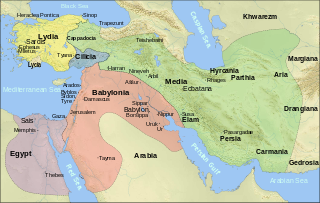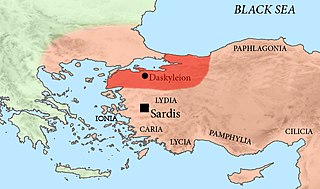Related Research Articles

A satrap was a governor of the provinces of the ancient Median and Achaemenid Empires and in several of their successors, such as in the Sasanian Empire and the Hellenistic empires.

Hyrcania is a historical region composed of the land south-east of the Caspian Sea in modern-day Iran and Turkmenistan, bound in the south by the Alborz mountain range and the Kopet Dag in the east.

Liviu-Dieter Nisipeanu is a Romanian chess grandmaster. His peak FIDE rating was 2707 in October 2005, when he was ranked fifteenth in the world, and the highest rated Romanian player ever. His highly aggressive style of play has earned him a reputation of a modern-day Mikhail Tal.
Peithon or Pithon was the son of Crateuas, a nobleman from Eordaia in western Macedonia. He was famous for being one of the bodyguards of Alexander the Great, becoming the later satrap of Media, and claiming to be one of the diadochi.

The Anyuak, also known as Anyuaa and Anywaa, are a Luo Nilotic ethnic group inhabiting parts of East Africa. The Anuak belong to the larger Luo family group. Their language is referred to as Dha-Anywaa. They are primarily found in Gambela Region in western Ethiopia, and South Sudan. Group members number between 200,000 and 300,000 people worldwide. Many of the Anyuak people now follow Christianity. It is one of the first of the Nilotic groups to become almost entirely Christian, following the Shilluk people.

Margiana is a historical region centred on the oasis of Merv and was a minor satrapy within the Achaemenid satrapy of Bactria, and a province within its successors, the Seleucid, Parthian and Sasanian empires.

Peucestas was a native of the town of Mieza, in Macedonia, and a distinguished officer in the service of Alexander the Great. His name is first mentioned as one of those appointed to command a trireme on the Hydaspes. Prior to this he must have distinguished himself for his personal valour and prowess, as he was the person selected by Alexander to carry before him in battle the sacred shield, which he had taken down from the temple of Athena at Troy. In this capacity he was in close attendance upon the king's person in the assault on the capital city of the Malavas ; and all authors agreed in attributing the chief share in saving the life of Alexander upon that occasion to Peucestas, while they differed as to almost all the other circumstances and persons concerned.
The history of Persian Egypt is divided into two eras following the first Achaemenid conquest of Egypt punctuated by an interval of independence:

Megabazus, son of Megabates, was a highly regarded Persian general under Darius, to whom he was a first-degree cousin. Most of the information about Megabazus comes from The Histories by Herodotus.

The Kingdom of Cilicia was an independent state that existed from 612 BC to 549 BC. The state was governed by the Syennesis dynasty, possibly from Greeks that moved into Cilicia towards the end of the Bronze Age. Prior to and after the independent kingdom, the Syennesis dynasty ruled Cilicia as autonomous state under the Neo-Assyrian Empire, Achaemenid Empire and the Alexander the Great’s Empire.

Bactria was a satrapy of the Achaemenid Empire. It was conquered between 545–540 BC by Cyrus the Great.

Arabia was a satrapy (province) of the Achaemenid Empire. Achaemenid Arabia corresponded to the lands between Nile Delta (Egypt) and Mesopotamia, later known to Romans as Arabia Petraea. According to Herodotus, Cambyses did not subdue the Arabs when he attacked Egypt in 525 BCE. His successor Darius the Great mentions the Arabs in the Behistun inscription from the first years of his reign, and in later texts. This suggests that Darius might have conquered this part of Arabia, or that it was originally part of another province, perhaps Achaemenid Babylonia, but later became its own province.

Tog Wajaale is a city on the border of Somaliland and Ethiopia. Tog Wajaale is the main border crossing for goods coming in and out of Somaliland, primarily from the port city of Berbera, Somaliland's main port.
Antiochus was a Seleucid prince, first-born child to the Seleucid monarchs Antiochus III the Great and Laodice III, and his father's first heir.

The Achaemenid conquest of the Indus Valley refers to a process beginning in the 6th century BCE and ending in the 4th century BCE, whereby the Achaemenid Persian Empire established control over the northwestern regions of the Indian subcontinent, today predominantly comprising the territory of Pakistan. The first of the two main invasions was conducted around 535 BCE by Cyrus the Great, who annexed the areas to the west of the Indus River, consolidating the early eastern border of the Achaemenid Empire. With a brief pause after Cyrus' death, the campaign continued under Darius the Great, who began to re-conquer former provinces and further expand Persia's political boundaries. Around 518 BCE, Persian armies under Darius crossed the Himalayas into India to initiate a second period of conquest by annexing regions up to the Jhelum River in Punjab.

Hellespontine Phrygia or Lesser Phrygia was a Persian satrapy (province) in northwestern Anatolia, directly southeast of the Hellespont. Its capital was Dascylium, and for most of its existence it was ruled by the hereditary Persian Pharnacid dynasty. Together with Greater Phrygia, it made up the administrative provinces of the wider Phrygia region.

The Oromo conflict is a protracted conflict between the Oromo Liberation Front (OLF) and the Ethiopian government. The Oromo Liberation Front formed to fight the Ethiopian Empire to liberate the Oromo people and establish an independent state of Oromia. The conflict began in 1973, when Oromo nationalists established the OLF and its armed wing, the Oromo Liberation Army (OLA). These groups formed in response to prejudice against the Oromo people during the Haile Selassie and Derg era, when their language was banned from public administration, courts, church and schools, and the stereotype of Oromo people as a hindrance to expanding Ethiopian national identity.
The battle of the 25 of Abu of 309 B.C. in an unknown location between Babylon and Susa, was the decisive and final clash of the Babylonian war. It ended in a Seleucid victory, and the establishment of the Seleucid kingdom
The Second siege of Babylon took place during the Babylonian War in 310 BC. Antigonid forces under Antigonus's oldest son, Demetrius, besieged the Seleucid garrison of the city of Babylon under the command of Patrocles.
References
- ↑ Mitchell, Daniel (2022-10-11). "Ethiopians: Herodotos on southern peoples at the ends of the earth (mid-fifth century BCE) | Ethnic Relations and Migration in the Ancient World: The Websites of Philip A. Harland" . Retrieved 2023-06-18.
- ↑ Vasunia, Phiroze (2016-03-01). "Ethiopia and India: Fusion and Confusion in British Orientalism". Les Cahiers d'Afrique de l'Est (51): 21–43. doi: 10.4000/eastafrica.314 . ISSN 2071-7245. S2CID 164634787.
- ↑ "Satraps and satrapies - Livius". www.livius.org. Retrieved 2023-06-18.
